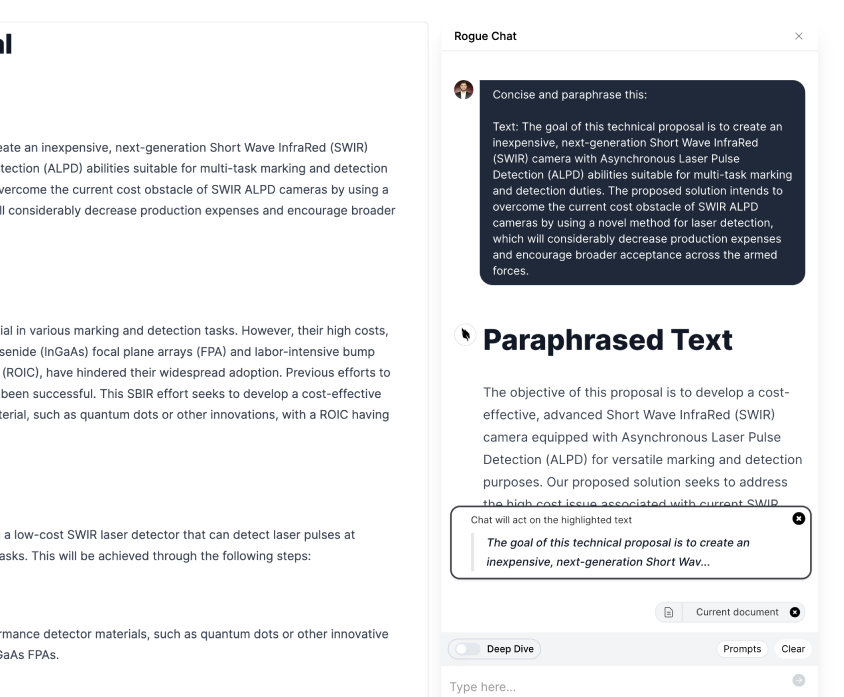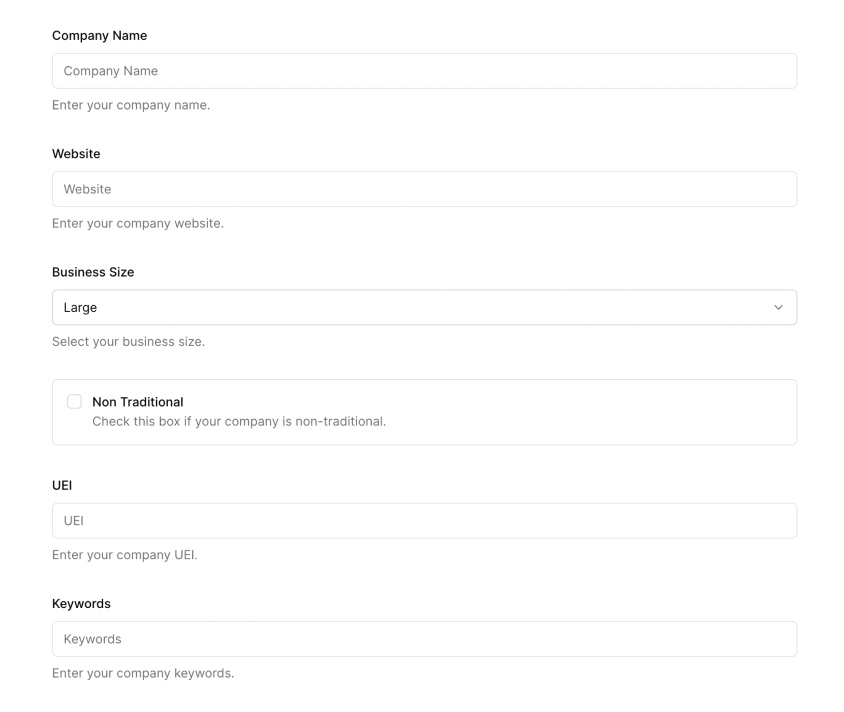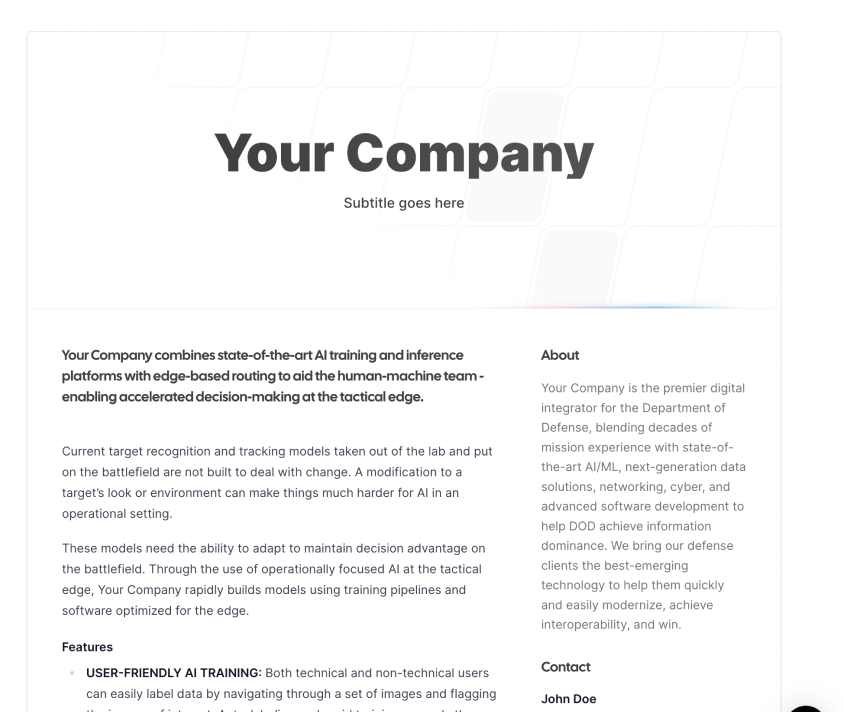
4.0 The DoD R&D Ecosystem
There are many players in the DoD R&D ecosystem, and many dynamics that come with them.
There are plenty of players in the DoD R&D ecosystem, some are more overt than others. At the end of the day, there's only so much R&D money in the budget, so you should know your competitors.
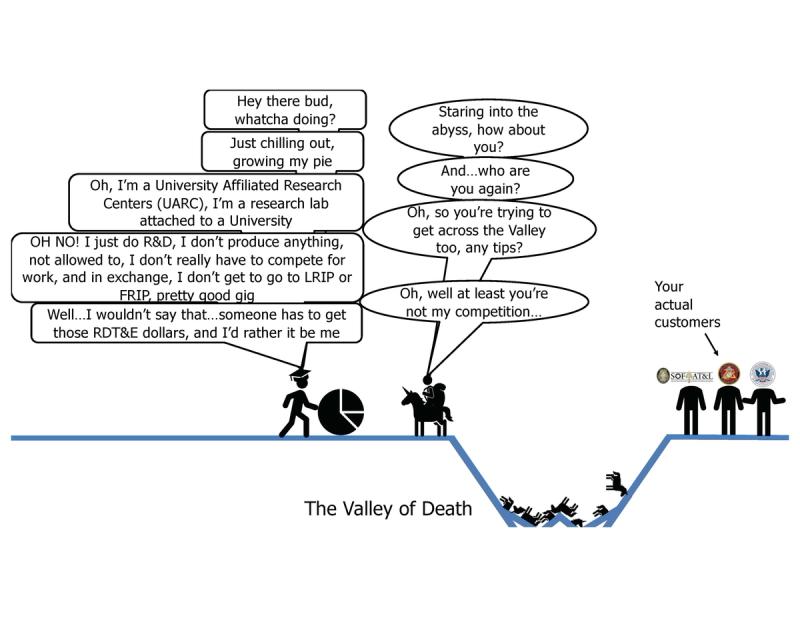
UARCs, or University Affiliated Research Centers, are research organizations that are formally linked to universities, but operate as separate entities. They are often established to conduct research and development projects, primarily for government agencies, leveraging the expertise and facilities of the affiliated university.
In the context of a small company competing for government research contracts, UARCs can be formidable competitors. They typically have access to extensive resources, such as highly qualified researchers, state-of-the-art facilities, and a strong track record of successfully executing government-funded projects. Additionally, their affiliation with prestigious universities can give them an edge in terms of credibility and perceived expertise.
It is also pretty easy to award sole-source contracts to UARCs for particular types of research as they are considered trusted and neutral third parties; neither industry nor government.
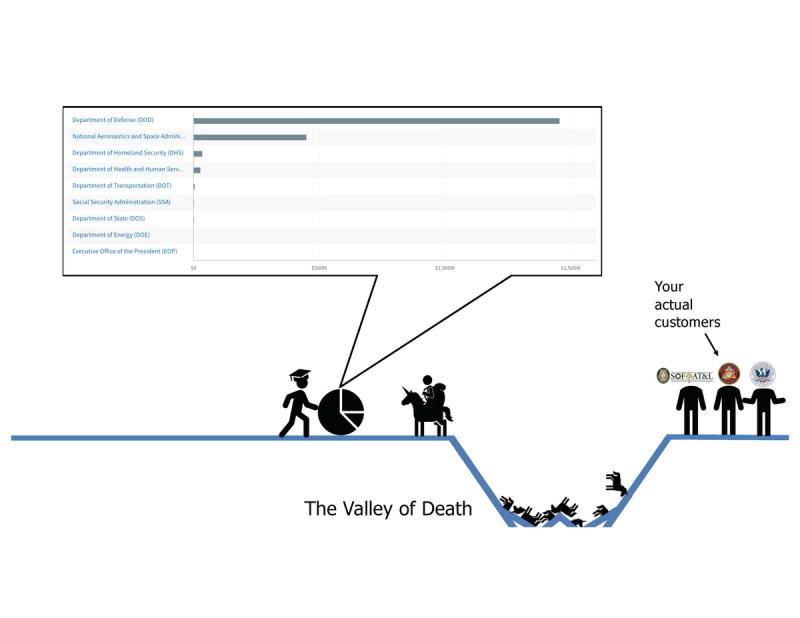
Don't let the University affiliation fool you, these research houses are MASSIVE, pulling down billions of dollars in research every year. While they're not for-profit, they (their researchers) do have a motive and incentive to win government research contracts, including the ones you might want to win. That chart above is only ONE UARC for ONE YEAR.
Here a list of current DoD University Affiliated Research Centers (UARCs) with their affiliated universities and research focus areas:
1. Georgia Tech Research Institute (Georgia Institute of Technology) - Aerospace, cybersecurity, defense, energy, healthcare, logistics, manufacturing, national security
2. Institute for Soldier Nanotechnologies (MIT) - Nanotechnology for soldier protection and performance
3. Institute for Collaborative Biotechnologies (UC Santa Barbara) - Biotechnology for defense and homeland security
4. Institute for Creative Technologies (USC) - Virtual reality, computer graphics, immersive technologies for training, health, entertainment
5. Applied Physics Laboratory (Johns Hopkins) - Air and missile defense, asymmetric operations, cyber operations, homeland protection, national security analysis, space exploration, technology for health
6. Applied Physics Laboratory (Penn State) - Advanced materials, manufacturing, naval systems
7. Applied Physics Laboratory (University of Hawaii) - Ocean science, environmental systems, maritime security
8. Applied Physics Laboratory (University of Texas at Austin) - Acoustics, electromagnetics, information operations, remote sensing
9. Applied Physics Laboratory (University of Washington) - Ocean science, environmental systems, maritime security, advanced materials/sensors
10. Space Dynamics Laboratory (Utah State University) - Space system design, small satellites, sensor systems
11. Systems Engineering Research Center (Stevens Institute of Technology) - Systems engineering, resilient systems, model-based systems engineering
12. Applied Research Laboratory for Intelligence & Security (University of Maryland) - Intelligence analysis, cybersecurity, language processing
13. National Strategic Research Institute (University of Nebraska) - Nuclear detection and deterrence, combating weapons of mass destruction
14. Geophysical Detection of Nuclear Proliferation (University of Alaska) - Monitoring underground nuclear explosions
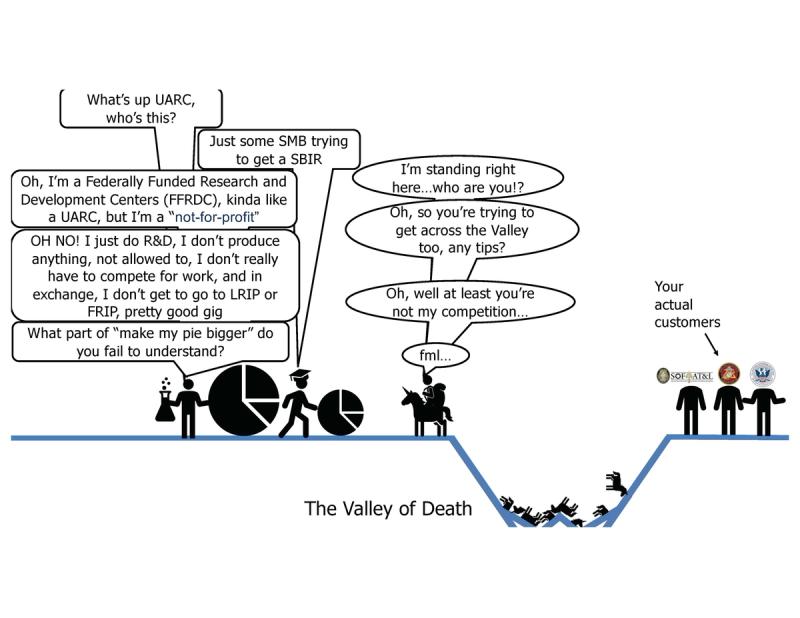
Similar to UARCs in form and function, the FFRDC's are specialized R&D organizations sponsored and funded by the U.S. government to meet long-term engineering, research, and analytical needs that cannot be easily met by government or commercial entities alone. They are operated by universities, non-profits, or private companies under long-term contracts with government agencies.
FFRDCs can be formidable rivals. They have several key advantages:
- Established long-term sponsorship and funding from government agencies.
- Access to specialized facilities, equipment, and top technical talent.
- Perceived objectivity and expertise in core areas of government interest.
- Ability to take on long-term, complex R&D projects.
FFRDC's are broken into research focus areas:
Study & Analysis Centers:
- Center for Naval Analyses (CNA) - Provides analyses and studies focused on issues of particular concern to the Navy.
- Institute for Defense Analyses (IDA) - Studies & Analyses - Addresses national security issues, particularly those requiring scientific and technical expertise.
- RAND Corporation - Arroyo Center - Focuses on policy analyses of strategy, doctrine, and force design for the Army.
- RAND Corporation - National Defense Research Institute (NDRI) - Conducts research and analyses for the Office of the Secretary of Defense and other government agencies.
- RAND Project Air Force - Performs analyses on strategy, doctrine, and force structure for the Air Force.
Systems Engineering & Integration Centers:
- Aerospace Corporation - Provides objective technical analyses and assessments for space programs.
- MITRE Corporation - National Security Engineering Center (NSEC) - Supports systems engineering and integration for the DoD's command, control, communications and intelligence systems.
Research & Development Laboratories:
- Institute for Defense Analyses (IDA) - Communications & Computing - Conducts R&D in communications, computing, and information processing for the NSA.
- MIT Lincoln Laboratory - Focuses on R&D in sensors, sensor systems, and complex integrated systems for national security.
- Software Engineering Institute (SEI) - Conducts software engineering research and development for DoD acquisition programs.
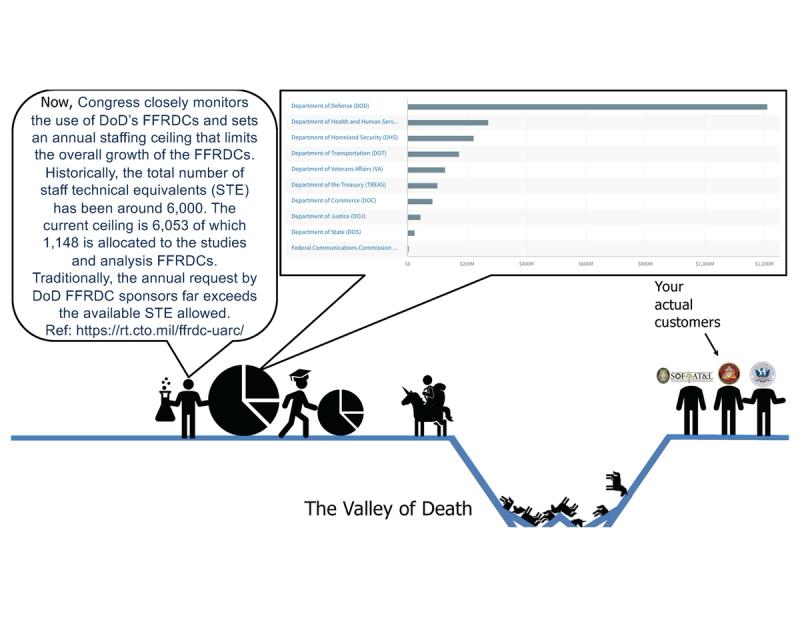
Again, FFRDC's land massive contracts and do work in the billions of dollars. Now, they tool are prohibited from entering full production, but they make some prototypes that are fairly operational.
Again, That chart above is only ONE FFRDC for ONE YEAR
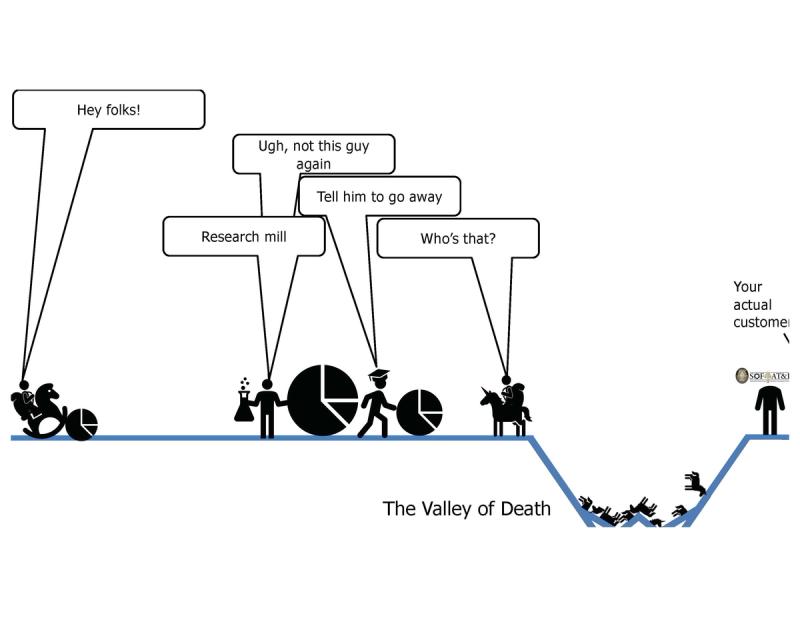
SBIR Mills and other research for hire orgs are an often hotly contested topic in the DoD R&D ecosystem. There are companies that receive more than 10 SBIR awards per year, and there are research houses who pull down 10's of millions in researc contracts from the various labs.
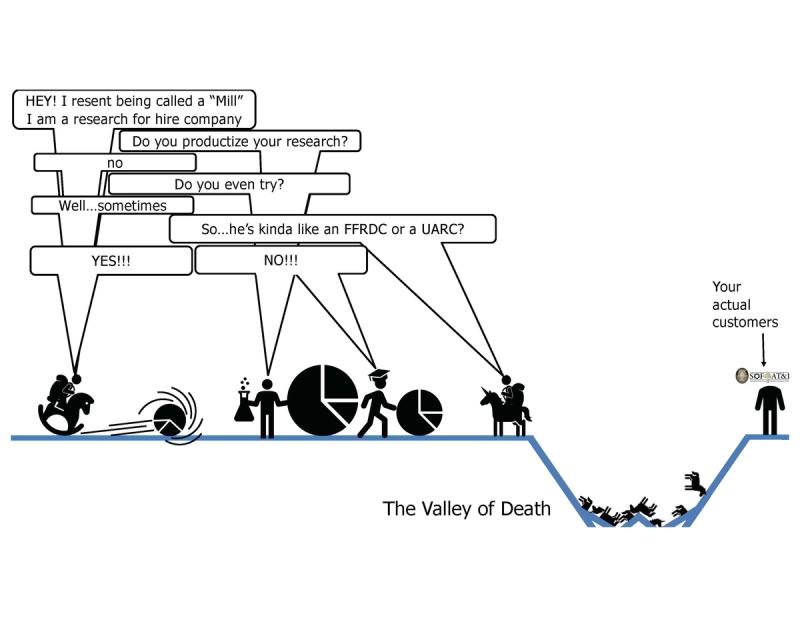
The bone of contention comes in that these organizations have no intent to commercialize the technology that the government is paying to develop. They live from research contract to research contract, but unlike UARCs and FFRDCs, these folks are for-profit. Also, the kinds of research that these folk propose to could and should have the opportunity for commercialization.
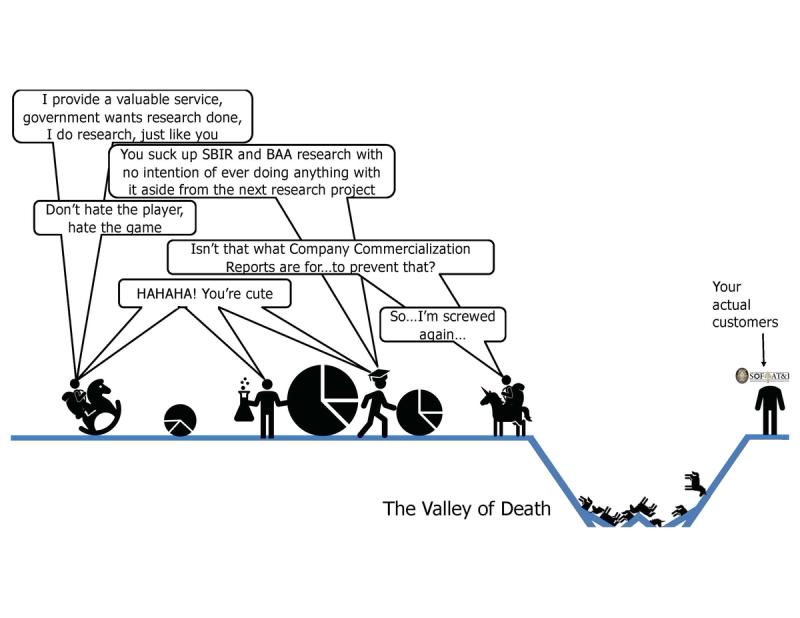
One would think that the government would take issue with the lack of commercialization and these shops would start losing because they fail to turn their research into products that the government can then buy and deliver as capabilities. You would be wrong.
There is an inherent misalignment on incentives between government research organizations (DARPA, ARL, AFRL, NRL, etc) and their customers who ultimately benefit from commercialization.

The government research organizations need to get research done, these research mills are pretty well practiced at doing said research, so from the research lab's point of view, they're a good bet.
From the end-user customer perspective, this is confounding and frustrating because the research mills never turn their cool new research into usable products.

Last but not least, you have large companies. These folks typically do not do research for research's sake, they are developing upgrades to their current products, on behalf of the government.
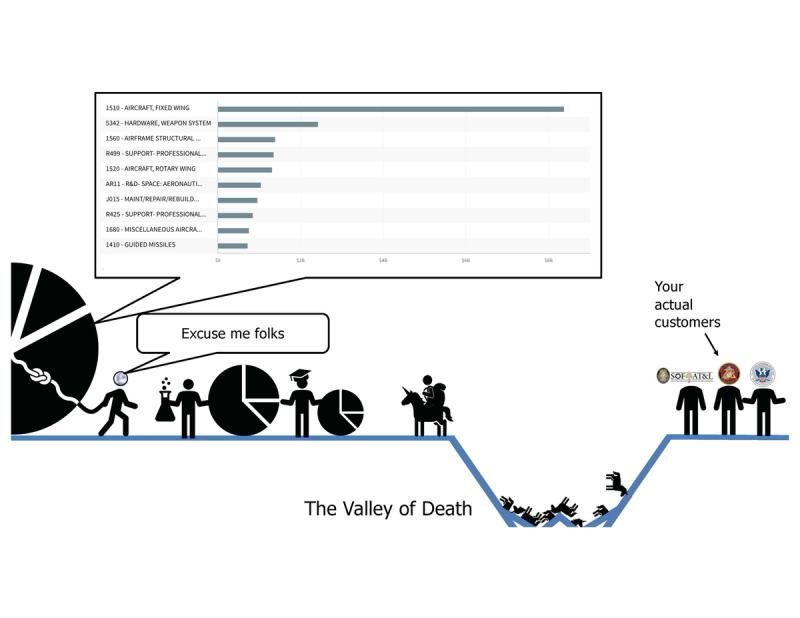
the R&D funding that goes into these large companies is significant.
Additionally, these large companies have a similar point of view as the research mills, but with a strategic perspective:
They may CHOOSE not to incorporate new technology right away, they may put it on the shelf for a while.
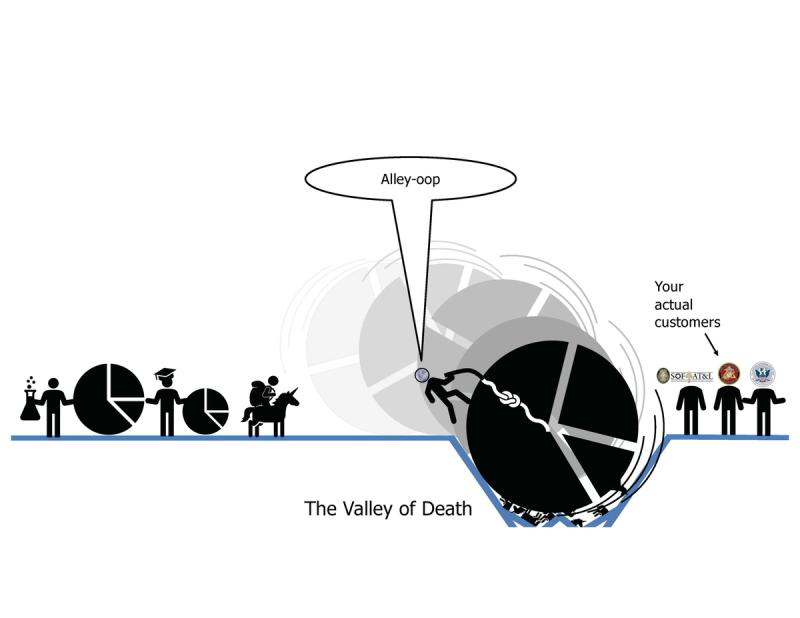
Think about it:
You're a massive company selling billions of dollars in products to the DoD
The DoD pays you to build new features and new technology that could upgrade your products
But, you only get paid for upgrades when the government actually asks for them...if you add a new feature to the F35 that the government doesn't ask for, then you might actually be breaking the law.
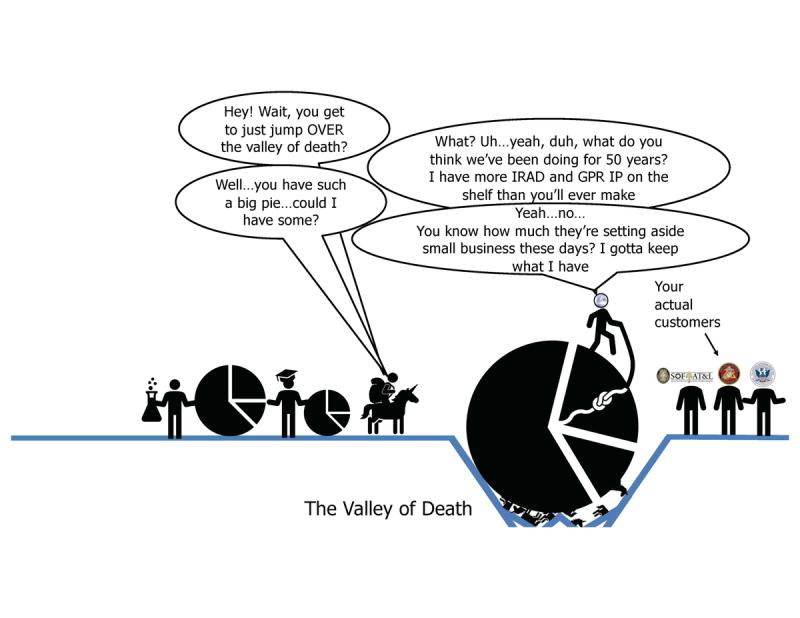
So, if you're big company you choose when to add these new features by encouraging their customers to add new technology upgrades to their contracts when it ideally suits them.
Think about it;
You're building a jet on the DoD dime
You're also building a death ray on the DoD dime
You're not going to slap a death ray on the jet if your next upgrade is for a gatling gun
You'll throw that death ray on the shelf for a couple years
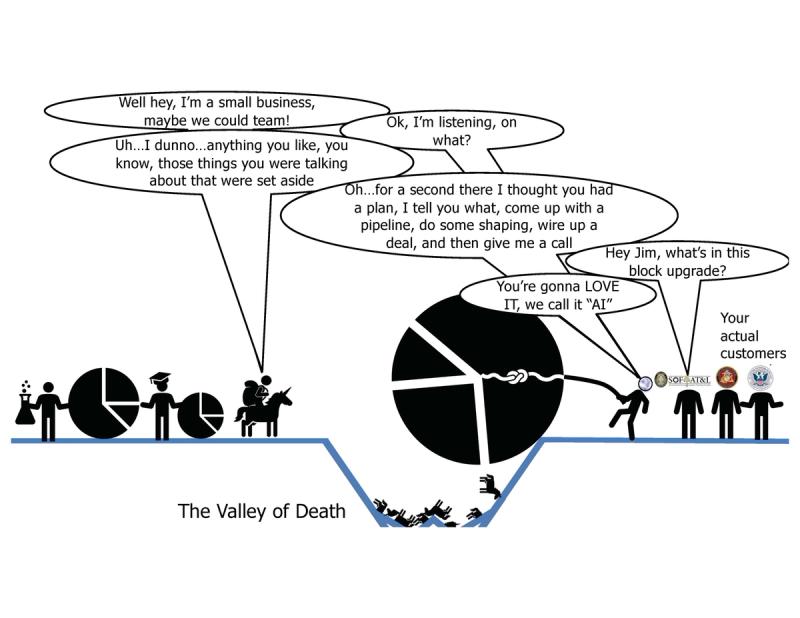
Partnering with a large business could be a great way in, after all that large company has current relationships with the customer, current funding, and their own bridge over the valley of death.
BUT, you're just one among thousands of small companies, why should they partner with you?
What do you bring to the table?
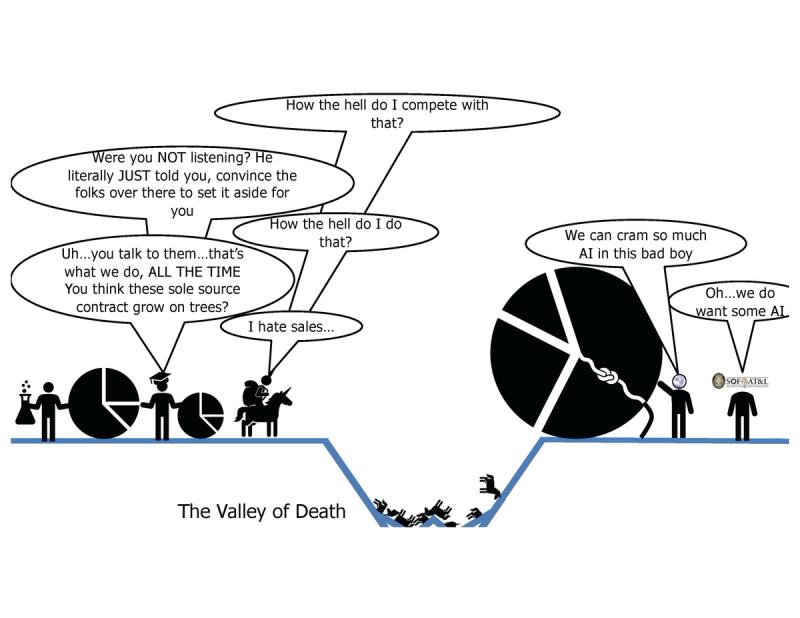
Remember, they're big, so their primary focus is on big contracts, but if you find a small business contract on which they could team with you, they're likely happy to be a subcontractor.
How do you find small business contracts? you look for them.

You can also engage with customers and get work set aside for small businesses.
Also, large buisness contracts often have small business contracting requirements.
Proactivity is key
Customer engagement is key
Focusing on what value you can offer to large companies is key
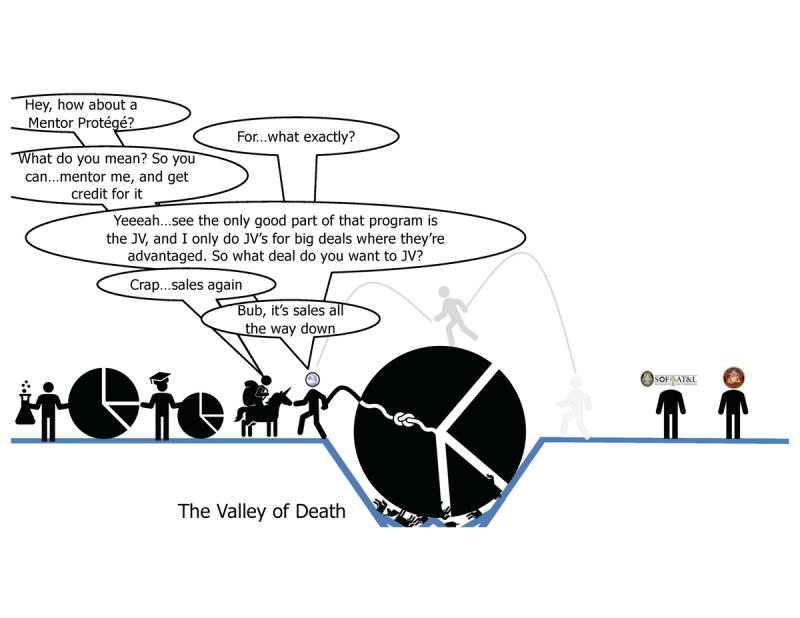
A lot of folks with think about the Mentor Protege program.
From the mentee perspective it's a great deal, according to the Small Business Administration:
"Protégés can get valuable business development help from their mentors in several areas, including:
- Guidance on internal business management systems, accounting, marketing, manufacturing, and strategic planning
- Financial assistance in the form of equity investments, loans, and bonding
- Assistance navigating federal contract bidding, acquisition, and the federal procurement process
- Education about international trade, strategic planning, and finding markets
- Business development, including strategy and identifying contracting and partnership opportunities
- General and administrative assistance, like human resource sharing or security clearance support"
The benefit to the mentor is basically just assuming the set asides of the mentee, again from SBA:
"A mentor and its protégé can joint venture as a small business for any small business contract, provided the protégé individually qualifies as small. The joint venture may also pursue any type of set-aside contract for which the protégé qualifies, including contracts set aside for 8(a), service-disabled veteran-owned, women-owned, and HUBZone businesses. Visit the Joint Venture program page more information."
So...doing a JV is basically like running a third company that's co-owned by the two companies, that's a major pain.
Large companies are not going to do that willy nilly.
IF YOU find a good opportunity AND there's an advantage to forming a JV, then they may opt to do so. Otherwise, likely a hard pass.
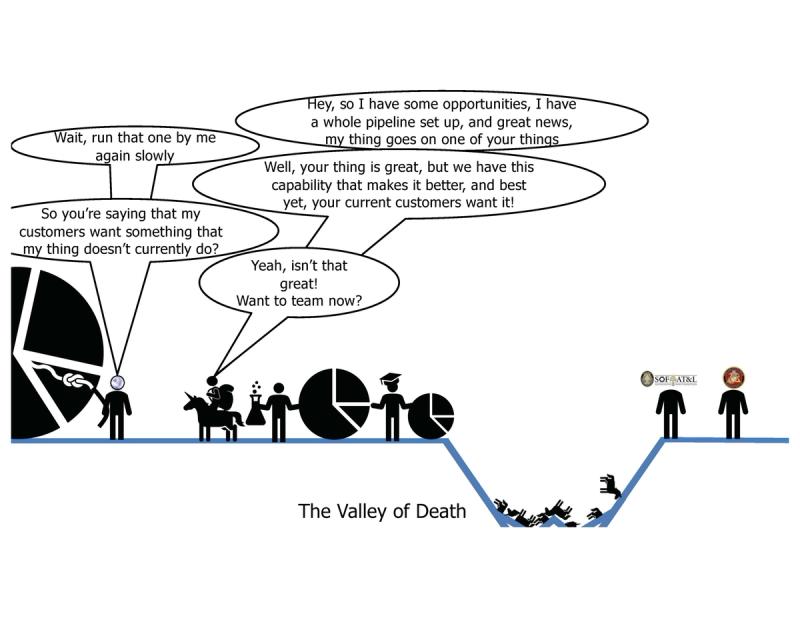
Now, the flip side is this: be aware of rice bowls. There's only so many pot of money, and it's very easy to inadvertently cut into someone else's pie.
Often times is it possible to grow the pie so that there's room for you to have pie and for the large company to NOT have a smaller pie.
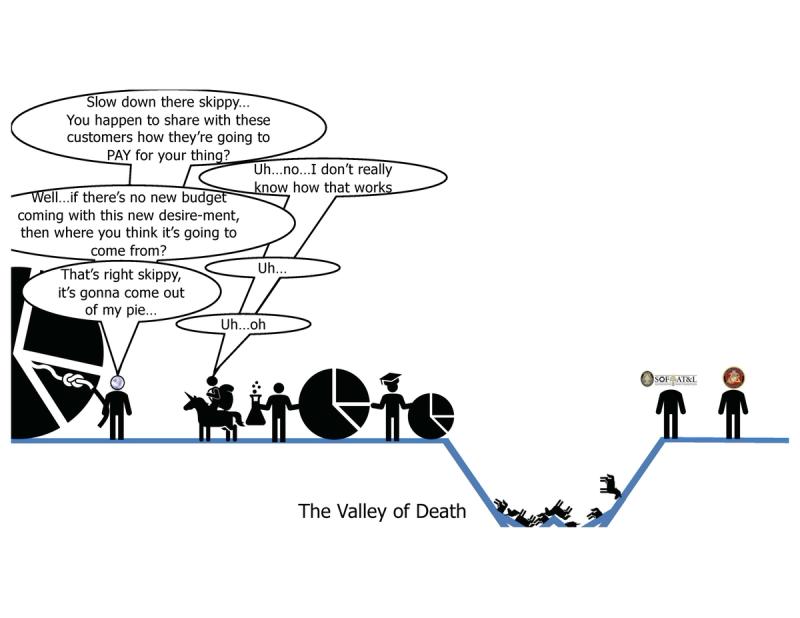
It's on you to do the extra homework and do the extra communication. If you can identify opportunities and engage with the large company on a regular basis and with transparency, you can build a great reputation, and become one of the trusted small companies to whom the large company goes when they need to fill out their small buisness goals.
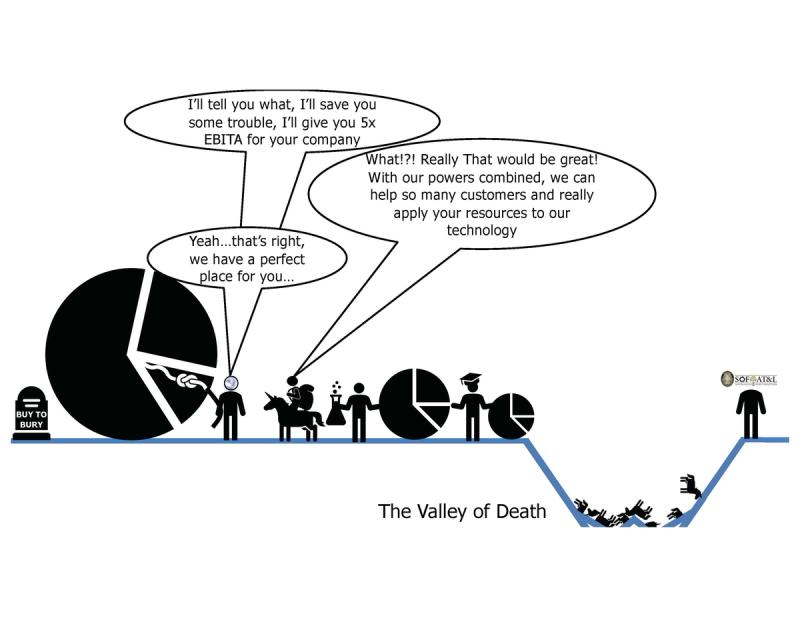
The worst possible eventuality is that you become a threat to the large company, at which point they may give you an offer you can't refuse and buy you out, or worse just bury you. The buy-to-kill/buy-to-bury potential is always present in the DefTech space, there are numerous and constantly growing list of companies with a new cool capability with great customer pull who then get bought out and the product stops getting developed. There's nothing worse than the thing you built getting buried in the bureaucracy of a large company.
Sign up for Rogue today!
Get started with Rogue and experience the best proposal writing tool in the industry.

